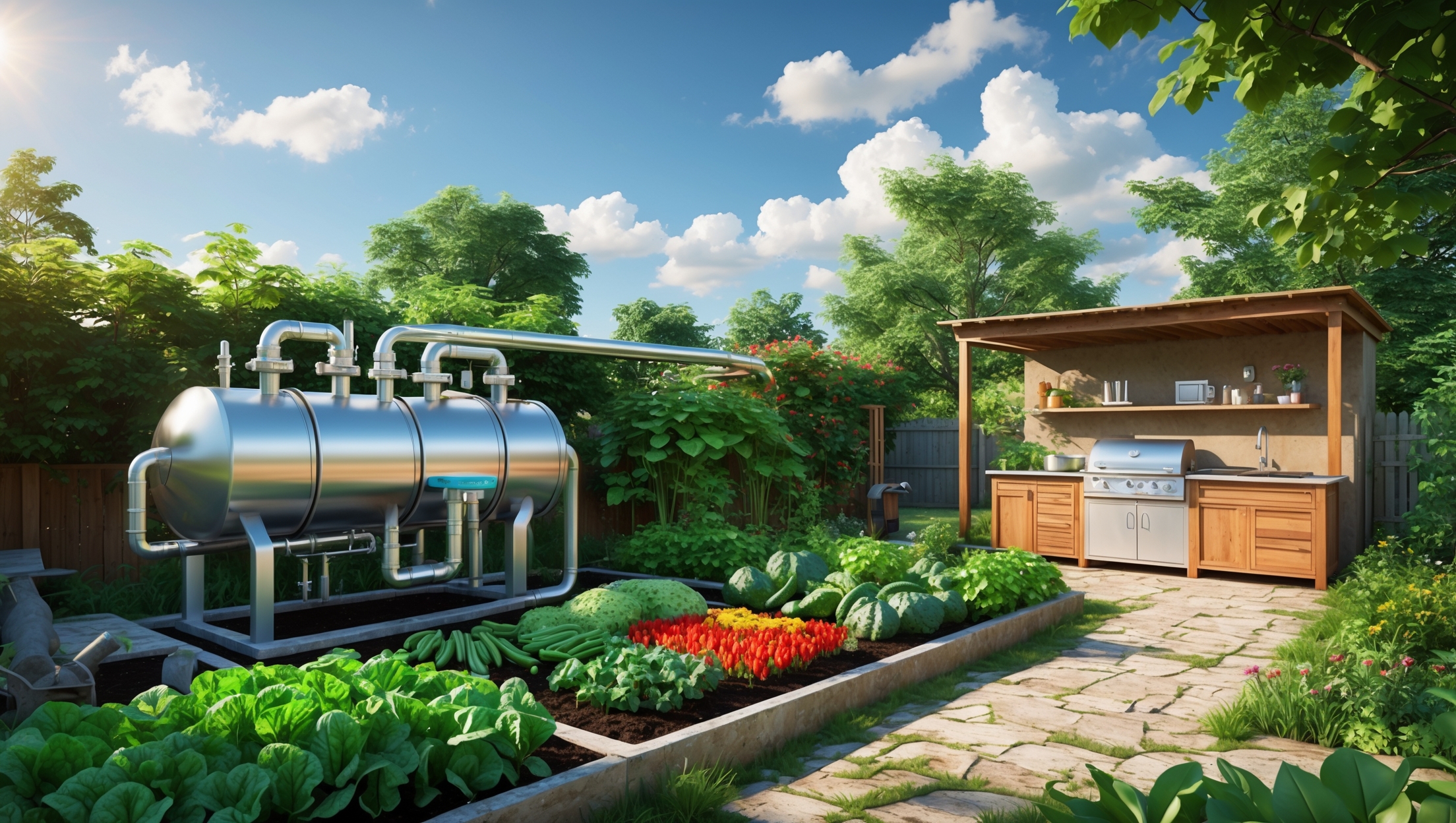Introduction: The Promise of Home Biogas Digesters
As the movement toward sustainable living accelerates, more homeowners are seeking practical ways to reduce their carbon footprint while reaping tangible benefits. One innovative solution rapidly gaining traction is the home biogas digester. These systems transform everyday organic waste—like kitchen scraps and yard trimmings—into renewable biogas for cooking and nutrient-rich fertilizer for gardens. Yet, for many, the path from curiosity to installation is paved with questions about costs, budgeting, and the true value of such an investment. This comprehensive guide will demystify the expenses associated with home biogas digesters, breaking down initial outlays, ongoing operational costs, potential savings, and tips for smart budgeting. Whether you’re motivated by eco-friendly ideals, energy independence, or long-term savings, understanding the financial landscape is crucial to making informed decisions and maximizing your return on investment. Let’s examine every facet of home biogas digesters—from up-front setup costs to ongoing maintenance—so you can confidently turn your household waste into a steady supply of clean, green energy.
Understanding Home Biogas Digesters: How They Work
Before diving into costs, it’s important to understand what a home biogas digester is and how it functions. A biogas digester is a sealed, oxygen-free (anaerobic) system that processes organic waste—such as food scraps, manure, and plant trimmings—using naturally occurring bacteria. These bacteria break down the material, producing a mixture of methane and carbon dioxide (biogas), which can be piped directly to a gas stove or heater. The process also yields a nutrient-rich slurry, perfect for fertilizing gardens and landscaping.
Types of Home Biogas Digesters
- Fixed Dome Digesters: Durable, underground systems with long lifespans but higher installation costs.
- Floating Drum Digesters: Feature a movable drum that collects gas; visible above ground and easier to monitor.
- Prefabricated Plastic Digesters: Plug-and-play systems, often above ground, suitable for smaller households and DIY installation.
Initial Costs: What to Expect Up Front
Home biogas digesters are a significant investment, but understanding the detailed breakdown of costs helps you budget effectively and avoid unpleasant surprises. Here’s what you’ll need to consider:
1. System Purchase Price
- Small-Scale Prefab Kits: $600–$1,500 (suitable for households of 2–5 people)
- Mid-Size Systems: $1,500–$4,000 (for larger families or those with livestock waste)
- Custom or Large-Scale Installations: $4,000–$10,000+
Costs vary based on the manufacturer, system capacity, and included features (e.g., integrated gas storage, filtration).
2. Site Preparation
- Ground leveling/excavation: $200–$1,000 (varies by site complexity)
- Foundation materials (concrete, gravel): $100–$400
- Plumbing and gas piping: $150–$600
DIY installation can reduce costs, but professional help may be needed for excavation, plumbing, and gas connections to ensure safety and compliance.
3. Permits and Compliance
- Local permits: $50–$300 (check with your municipality; some areas may require environmental, sanitation, or construction permits)
- Inspections: $100–$250 (if mandated by local authorities)
Failure to secure proper permits can result in fines or forced removal, so factor these costs into your budget early on.
4. Optional Accessories
- Gas appliances (biogas stoves, heaters): $80–$400 per unit
- Gas storage bags or cylinders: $50–$200
- Slurry pumps or irrigation attachments: $100–$300
5. Delivery and Installation
- Shipping fees: $50–$400 (varies by supplier and system size)
- Professional installation (if needed): $500–$2,000
Some manufacturers offer bundled installation, which can simplify logistics but may be more expensive than managing contractors independently.
Ongoing Operational Costs
Biogas digesters are designed for low maintenance and operation, but there are recurring costs to consider:
1. Feedstock (Organic Waste)
If you produce enough kitchen and yard waste, feedstock is essentially free. However, if supplementing with livestock manure or sourcing additional materials, transportation or purchase costs can arise ($0–$100/month for large systems).
2. Water Use
Digesters require water to mix with organic material. For a small system, expect 5–10 gallons per day—usually negligible on your water bill, but worth noting in dry climates. Rainwater harvesting can offset this cost.
3. Maintenance and Repairs
- Routine inspections and cleaning: $0–$50/year (DIY); $100–$200/year (professional)
- Replacement parts (valves, seals): $20–$100/year
Modern systems are robust, but accidental damage, clogging, or wear may require occasional part replacements.
4. Appliance Upgrades
If you expand usage (e.g., add a second biogas stove or heater), budget for new appliances as your needs evolve.
Potential Cost Savings and Payback
While the up-front investment can be significant, the long-term savings and environmental benefits often outweigh the initial costs. Here’s how:
1. Reduced Energy Bills
- Cooking Fuel: A typical household biogas system can replace 40–60% of LPG or natural gas used for cooking, saving $200–$500/year depending on usage and local rates.
- Water Heating: Some systems handle water heating, further reducing utility bills.
2. Fertilizer Savings
The nutrient-rich digestate produced by the system can replace commercial fertilizers. For a medium garden, this can save $50–$200 annually, and the organic content improves soil health long-term.
3. Waste Disposal Savings
Diverting organic waste from landfill can reduce municipal waste disposal fees—an often-overlooked benefit in regions where trash pickup is charged by volume or weight.
4. Environmental Incentives
Some regions offer rebates or tax credits for installing renewable energy systems, including biogas digesters. Check with local and national agencies for available programs; incentives can offset 10–30% of installation costs in favorable locations.
5. Payback Period Calculation
For a $2,000 system with combined annual savings of $400, the system pays for itself in five years—sooner if incentives apply or energy prices rise. Larger systems serving small farms or multi-family dwellings may see payback in 2–4 years.
Budgeting Strategies: Planning for Success
Budgeting for a home biogas digester is about more than tallying receipts—smart planning ensures your investment delivers maximum benefits with minimal stress. Consider the following steps:
1. Assess Your Waste Stream
- Track the amount and type of organic waste your household produces over a typical week.
- Use this data to select an appropriately sized digester—oversizing increases costs without added value.
2. Set a Realistic Budget
- Factor in all up-front and recurring costs (see above), including a 10–15% contingency for unexpected expenses.
- Investigate local incentives and rebates before committing.
3. Prioritize Features
- Decide if you need advanced features like automated feeding, gas filtration, or large storage capacity.
- Choose essential accessories first; luxuries can be added later as your system proves itself.
4. DIY vs. Professional Installation
- If you have plumbing and construction experience, DIY installation can reduce costs by 20–40%.
- Otherwise, budget for professional installation to ensure safety and compliance.
5. Plan for Maintenance
- Set aside an annual maintenance fund, even if your system is new and under warranty.
- Keep a small stock of spare parts (valves, hoses) on hand to avoid costly downtime.
Hidden and Indirect Costs to Watch For
While most costs are straightforward, a few indirect expenses can catch homeowners off guard:
- Time Commitment: Regular feeding and occasional cleaning are essential for optimal performance.
- Seasonal Performance: In cold climates, biogas production slows in winter—some systems may require insulation or supplemental heating ($50–$300 in materials).
- Insurance: Some insurers require notification of gas installations; check for any impact on premiums.
- Resale Value: While biogas systems can enhance eco-friendly appeal, their impact on property value varies by region and buyer preference.
Case Example: Budgeting a Backyard Biogas System
Let’s walk through a budgeting scenario for a typical suburban household:
- System: 2m³ prefabricated digester kit ($1,200)
- Site Prep: Minor leveling, DIY ($150)
- Plumbing & Gas Lines: ($250)
- Permits: ($100)
- Biogas Stove: ($120)
- Shipping: ($120)
- Contingency (10%): ($194)
- Total: $2,134
With anticipated annual fuel and fertilizer savings of $350, the payback period is just over six years (faster if you secure local incentives or use more biogas).
Tips to Reduce Costs and Maximize Value
- Start Small: Begin with a basic system and expand as your needs grow and confidence increases.
- Source Locally: Local suppliers may offer lower shipping and better support.
- Leverage Community: Pool resources with neighbors for bulk purchases or shared systems.
- DIY Where Safe: Simple site prep and feedstock collection can save money, but always seek professional help for gas connections and electrical work.
- Apply for Incentives: Stay updated on grants, rebates, and pilot programs in your area.
Conclusion: Investing in a Cleaner, Greener Future
Home biogas digesters represent more than a sustainable technology—they’re a pathway to energy self-sufficiency, waste reduction, and a healthier environment, all from the comfort of your backyard. While the up-front investment can feel daunting, a clear understanding of costs, careful budgeting, and strategic planning make this technology accessible for many households. By evaluating your waste stream, setting a realistic budget, and prioritizing features that match your lifestyle, you can ensure a smooth installation and rapid payback. Don’t overlook the value of ongoing savings: lower energy bills, free organic fertilizer, and positive environmental impact add up year after year.
As more communities embrace circular solutions, early adopters of biogas technology play a crucial role in driving grassroots sustainability. With smart budgeting and a willingness to innovate, you can turn everyday scraps into a source of clean, renewable energy—while inspiring neighbors to join the movement. After all, the true cost of inaction is far greater than the price of a well-planned digester system. So, take the first step: assess your needs, crunch the numbers, and start your journey toward a cleaner, greener, and more resilient future—one meal, one garden, and one household at a time.





If I install a home biogas digester, what is the usual timeframe before it starts producing usable biogas for cooking? Is it an immediate benefit or will it take months to see results?
After you install a home biogas digester, it typically takes 2 to 4 weeks before you start seeing usable biogas for cooking. This initial period allows the bacteria inside the digester to become active and start breaking down the organic waste. Once the process is established, you should have a steady supply of biogas as long as you continue feeding the system regularly.
I’m really interested in the idea of converting my kitchen scraps into biogas, but how much space would I actually need in my backyard for a typical fixed dome or floating drum digester?
For a typical household biogas digester, you’ll want to set aside about 2 to 5 square meters of space in your backyard. Fixed dome digesters are often built partially underground and can be quite compact, while floating drum types might need a bit more area for the drum to move freely. Make sure there’s also room for safe access and maintenance.